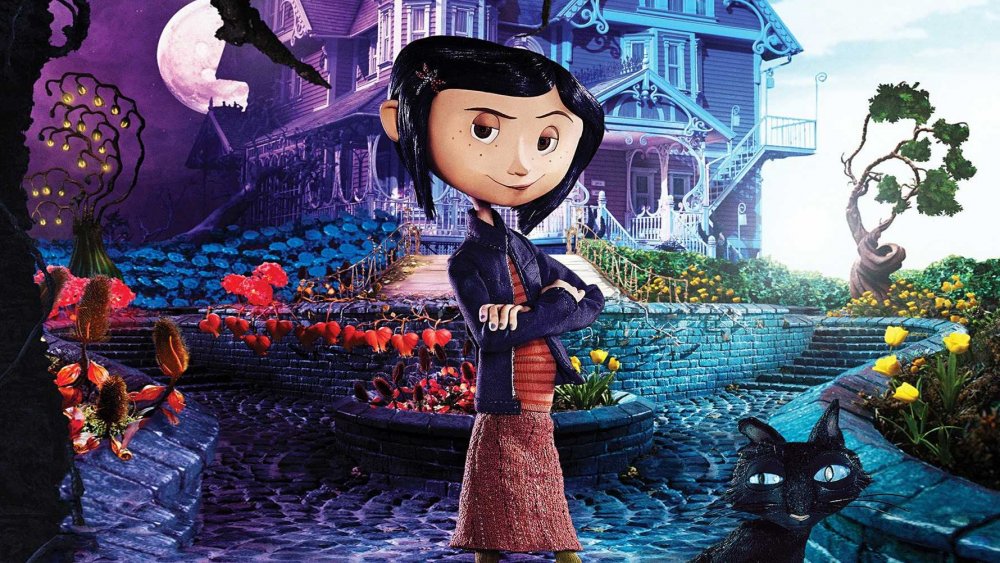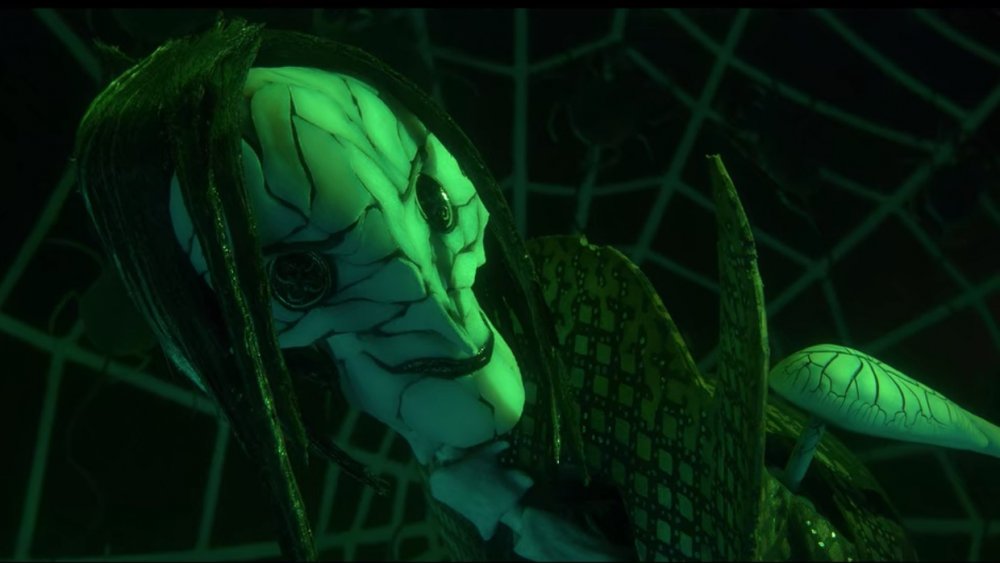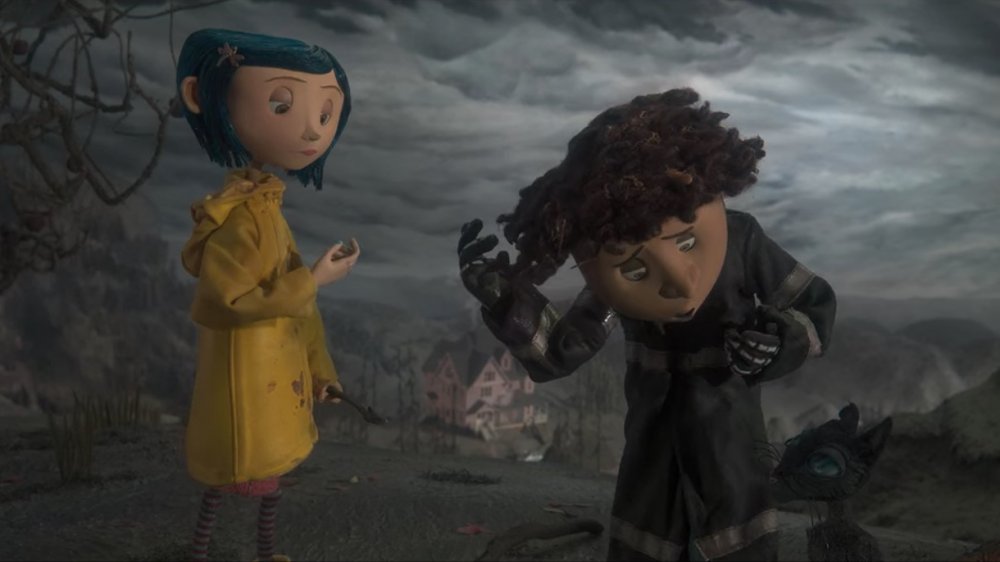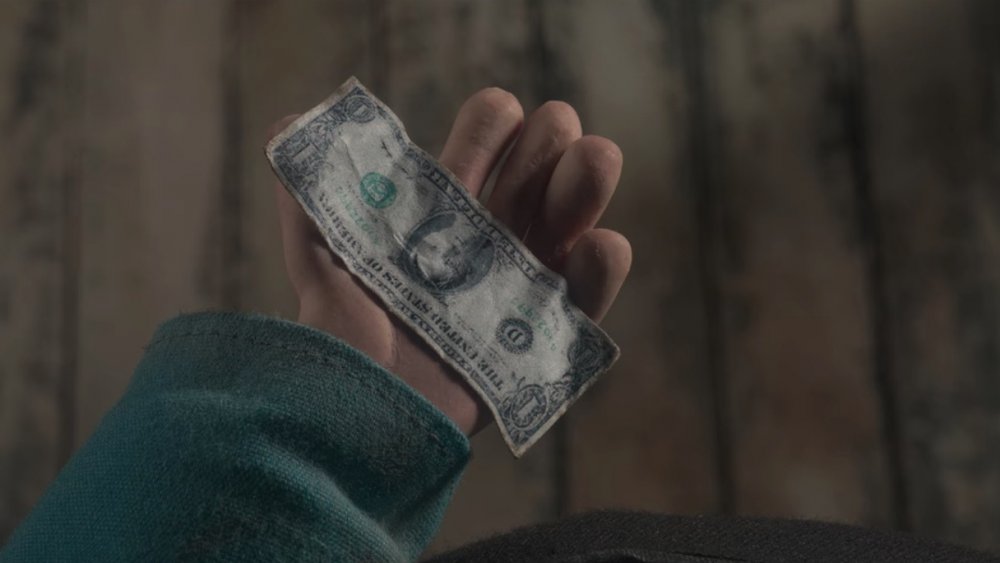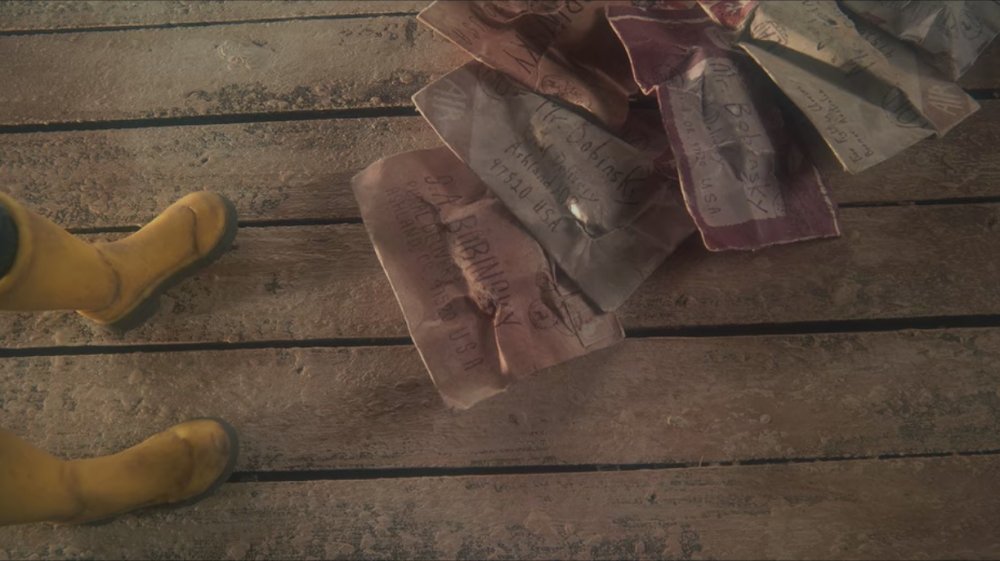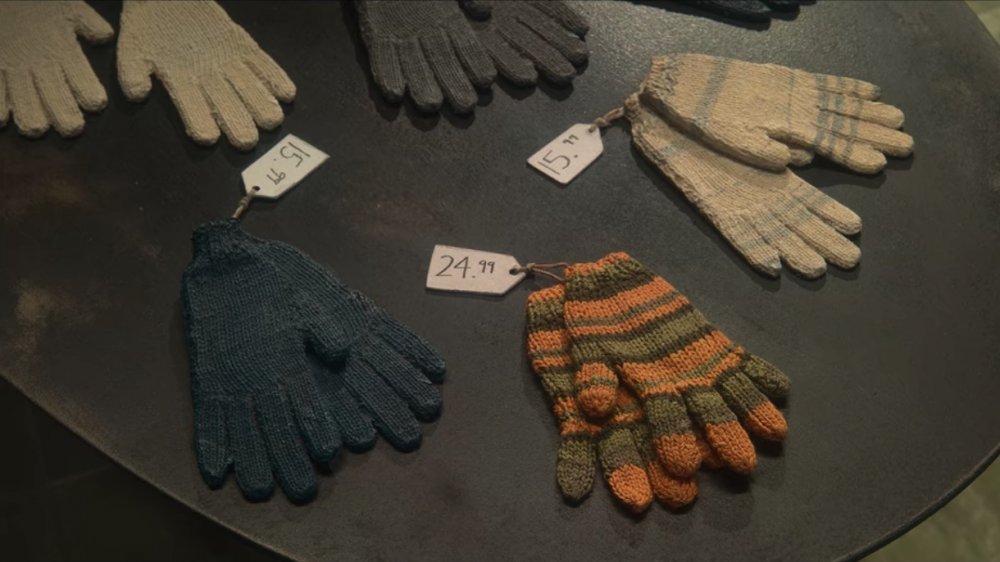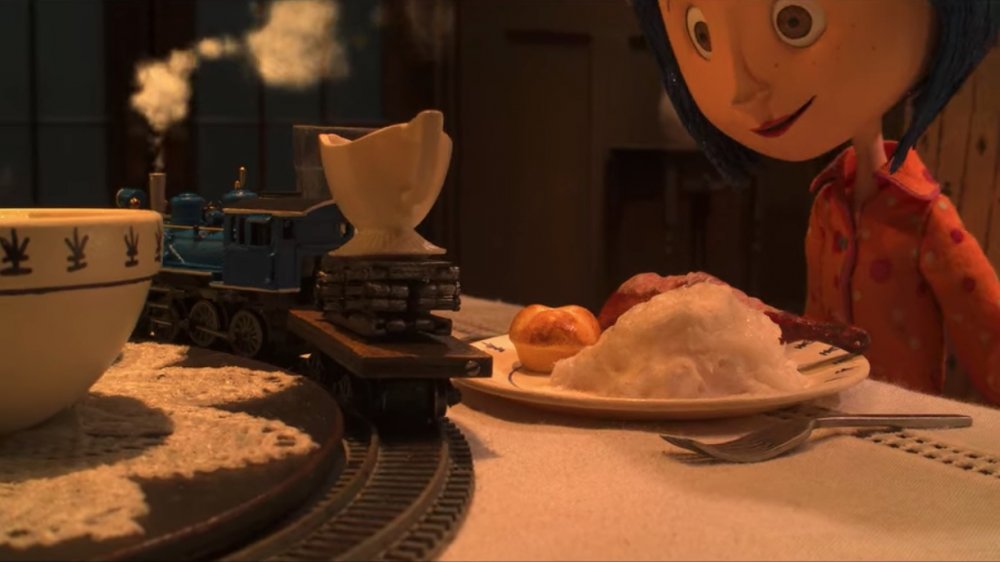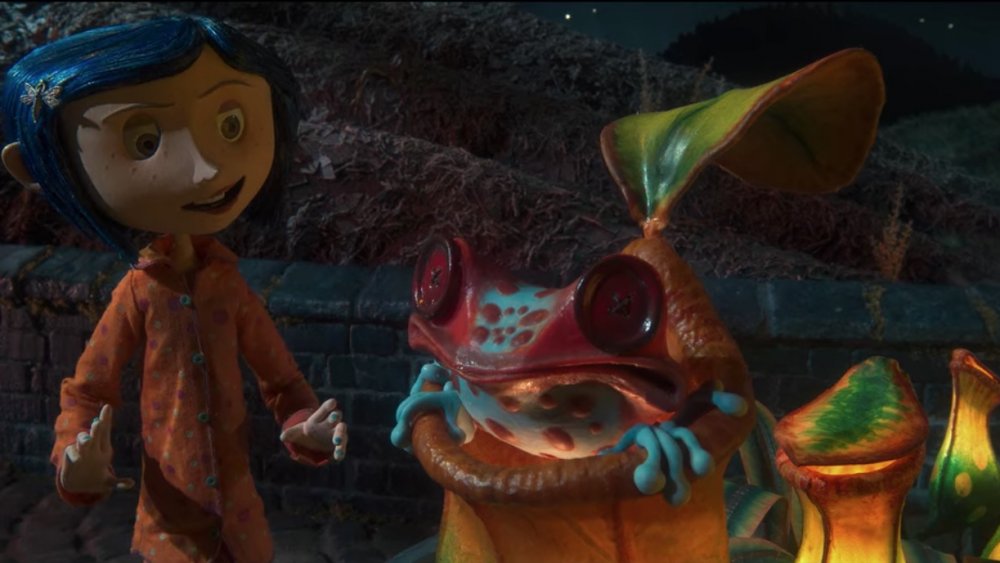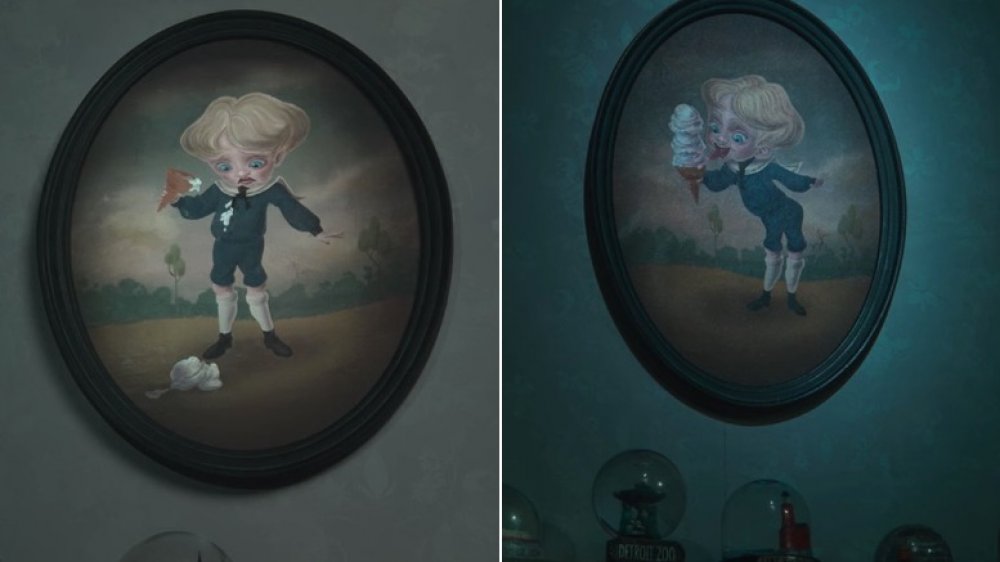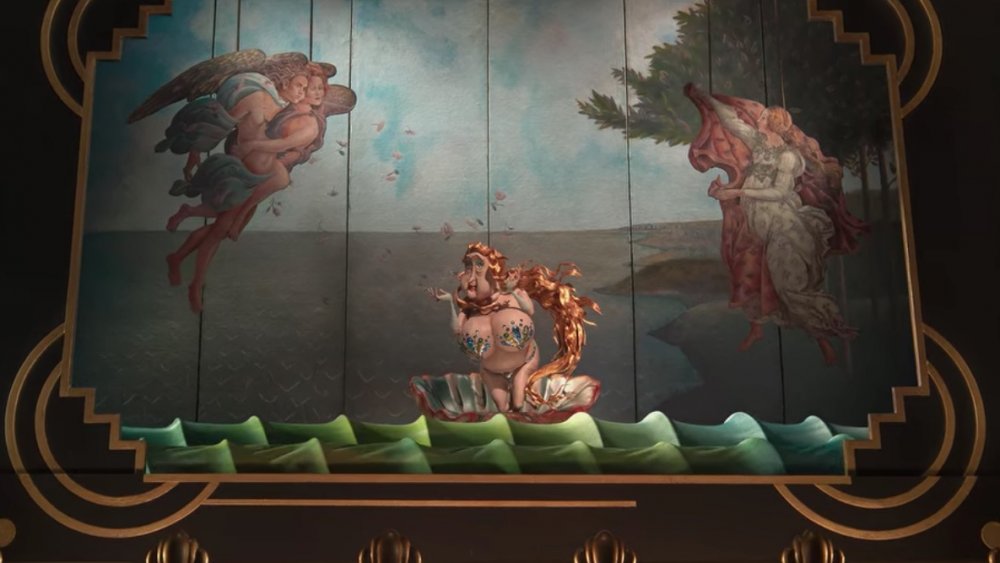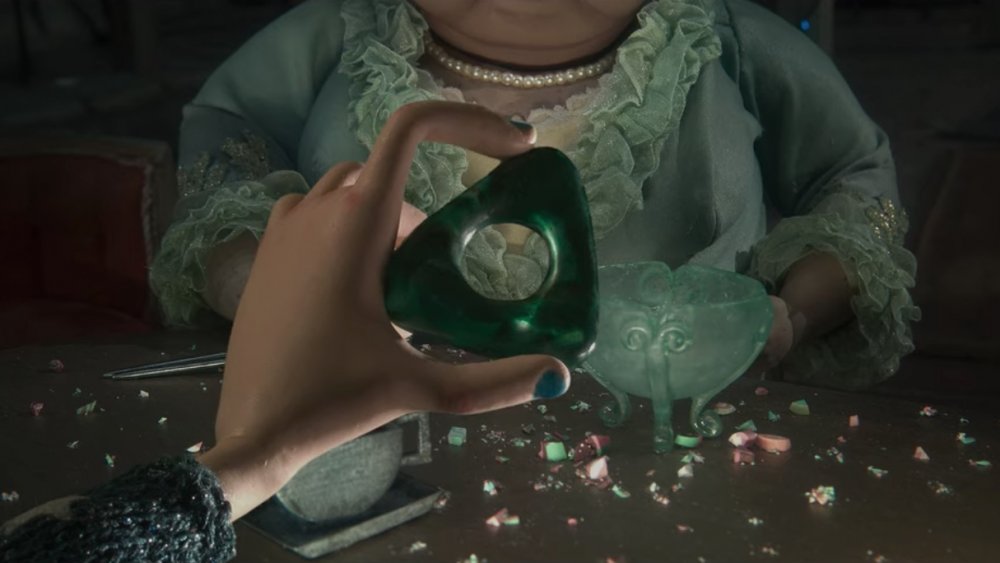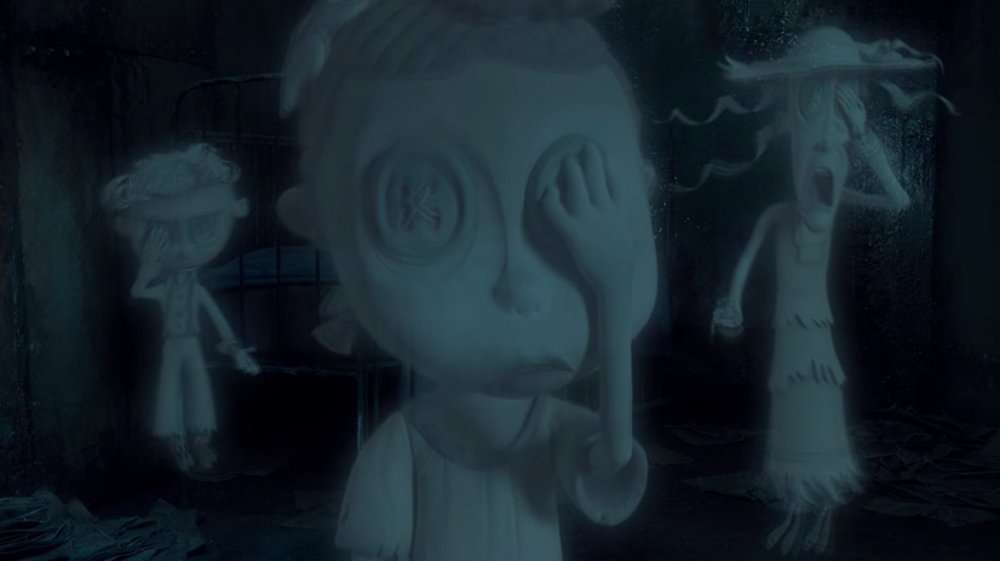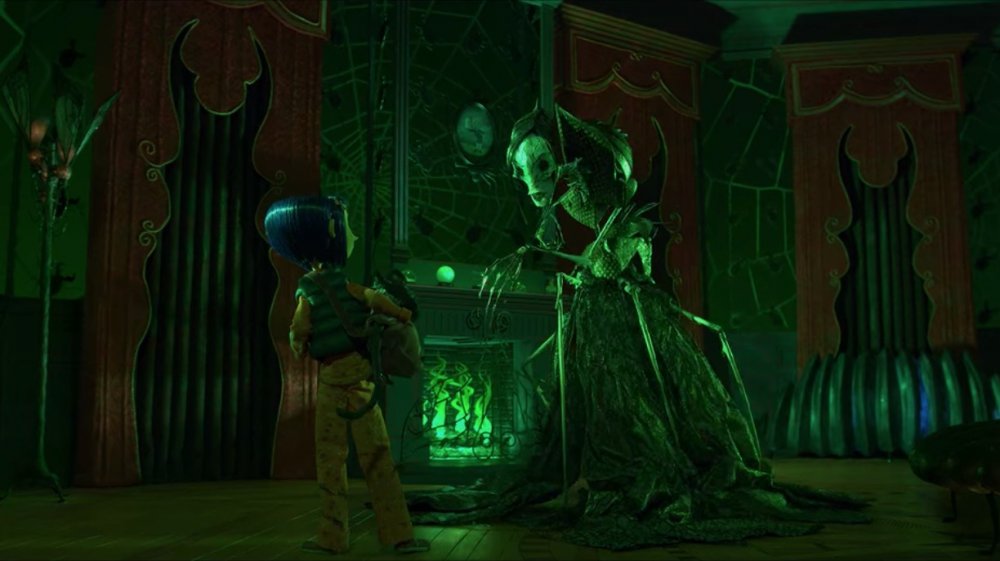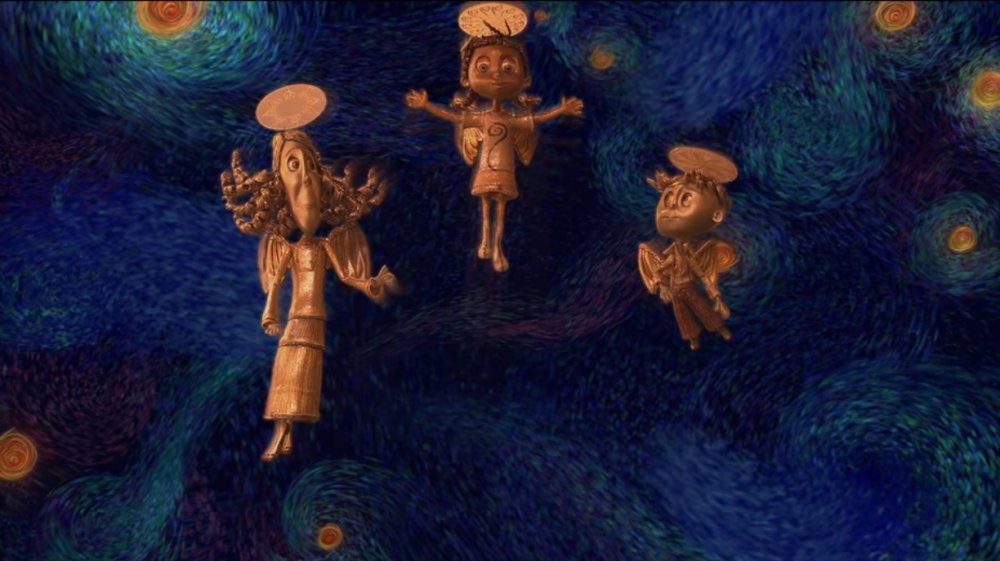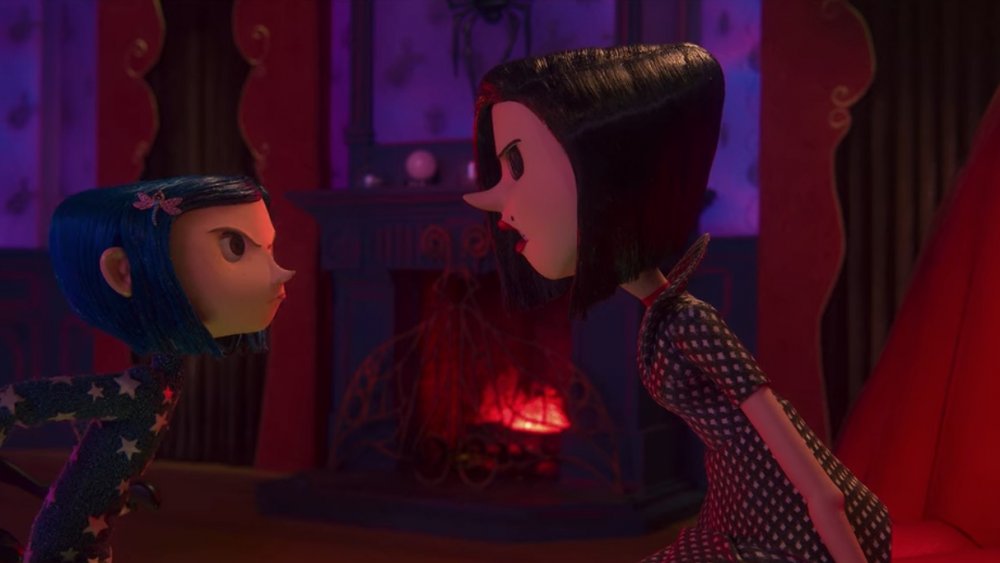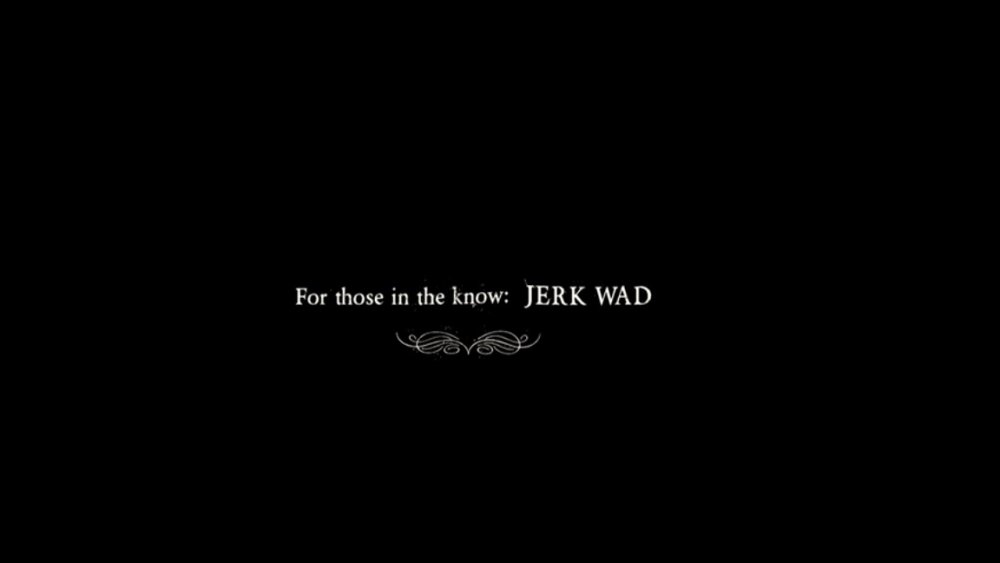Things Only Adults Notice In Coraline
Blue-haired Coraline — not Caroline — Jones (Dakota Fanning) is newly transplanted to Oregon from Michigan thanks to her parents' jobs as authors of gardening books, and she is really, really, really unhappy about it. As she explores her new home, a converted Victorian mansion called the Pink Palace that houses three different groups of tenants, Coraline finds a miniature door that opens up into a magical world that looks just like her own... only so much better.
In Henry Selick's stop-motion adaptation of Neil Gaiman's children's book of the same name, there are lots of things that everyone can't help but notice in Coraline. For example, it's clear her parents are extremely neglectful of her; her mother Mel (Teri Hatcher), in particular, doesn't seem to like her daughter very much at all — and makes no secret of it, either. Everyone can see that Coraline feels out of place in her new town, especially since everyone keeps pronouncing her name wrong. It's obvious that Coraline and her family are in the middle of a stressful situation, and she doesn't always help make things better.
But tucked away in the technicolor panels of Coraline and in the movie's snappy dialogue are many references that exist for the grown-ups watching along with their kids. Let's turn the button key and explore the things that only adults notice in Coraline.
This is actually a horror movie
Yes, lots and lots of children's movies are actually horror stories in disguise or have horror elements that drive the plot forward. Snow White, Sleeping Beauty, and even Bambi and The Lion King have moments as well as entire sequences that are legitimately terrifying involving monsters, attempted murder, and the death of a beloved parent. But these examples all have other beautiful moments of joy and happiness that balance out the darkness. This is not the case with Coraline. At all.
When Coraline goes through the enchanted portal in the Pink Palace, she comes upon a woman with buttons for eyes who seems to be an improved version of her own mother. At first, the Other Mother (also voiced by Teri Hatcher) impresses Coraline with her cooking, attentiveness, and constant gift-giving. But it's not long before Coraline discovers that this Other Mother, the Beldam, kidnaps children and feeds on their life forces until they die. Coraline even meets three of the child ghosts Other Mother murdered after sewing buttons on their eyes. And as Other Mother tries to weave Coraline into her toxic web, her appearance becomes more and more grotesque until she is not much more than sharp angles, jutting bones, and needles for hands.
Coraline almost dies on several occasions in her fight with Other Mother, and by the end of the movie it's unclear if she has actually defeated the Beldam once and for all. Should kids even be watching a movie like this?
Coraline can be as mean as both of her mothers
Coraline is precocious and intelligent, an old soul who seems far more adult than her actual pre-teen age. Animation has made her three-dimensional in her physicality, and the story's writing has made her character multidimensional and complex as well. But one of the darker aspects of Coraline that adults in particular would pick up on is how she can be as actively mean as both of her mothers.
Her Real Mother is extremely dismissive of her daughter and openly expresses how much of a nuisance she thinks Coraline is. In turn, Coraline is extremely dismissive and unnecessarily cruel to her new neighbor Wyborne "Wybie" Lovat (Robert Bailey Jr.). Wybie often has verbal diarrhea, it's true, but does that warrant Coraline calling him "Why-were-you-born," especially when she knows he's being raised by his grandmother?
Coraline also calls the Cat (Keith David) "wuss puss" on multiple occasions, but she actually apologizes for that once she realizes he can talk in the Other World. Adults will notice how the mild verbal abuse Coraline receives from her mother spills from Coraline onto others. It's another element that adds to the horror story reality of Coraline.
Coraline's dad only tips the movers $1
A move from Michigan to Oregon is no small feat, and Coraline's parents hired a moving company to help them out on the almost 2,400-mile journey. And while the Pink Palace has been broken up into three separate homes, Apartment A where the Jones family will be living takes up the majority of the main house. It's rather huge, to boot. After working all day to bring beds, boxes, and other furniture into the house, a distracted Charlie Jones (John Hodgman) almost doesn't tip the movers at all after signing for their things. When the mover politely reminds him, Charlie gives him a whopping one dollar.
Adults who've hired movers in the past know how hard they work and that the men who do the actual heavy lifting often rely on tips. It's clear the Jones family is worried about money as they finish their book, but that's no excuse to not to properly compensate people for their work. If they couldn't pay, they should have moved their stuff themselves. Kids probably won't notice the insult embedded in this moment.
Lots of Shakespeare references
Coraline's Oregon setting is mentioned many times by multiple characters. But only an adult would notice the city name, Ashland, on the packages of cheese Mr. Bobinsky (Ian McShane) gets to help train his mouse circus. Ashland is home to a renowned Shakespeare festival every year, a festival that appears to be happening while Coraline takes place. We see signs for the festival in town, and to really bring the message home for the theatre-loving adults in the room, Coraline has a number of Shakespeare references sprinkled in its dialogue.
"My kingdom for a horse," a kid shouts as he falls down the stairs of Linden's Department Store, a famous quote from Shakespeare's history-tragedy Richard III. The downstairs neighbors Miss Spinks (Jennifer Saunders) and Forcible (Dawn French) do a dance while reciting, "What a piece of work is man," an iconic monologue from Hamlet. And on the walls of Spinks and Forcible's apartment are posters for their old burlesque shows King Leer and Julius Sees Her. Only adults would notice that these titles sound like Shakespearean porn.
The gloves Coraline wants cost $25.99
When Coraline grudgingly goes into town with her mother to get her new school uniform since it's on sale for half off, she sees a pair of colorful yellow and red striped gloves that stand out among all the drab gray clothes in the department store. Barely containing her contempt for her daughter, Mel Jones won't even consider the gift for Coraline, not even by offering conditions for its purchase like chores or other things. She just says no.
While her mom is indeed a really unhappy and even cruel woman, when adults notice that the gloves Coraline wanted cost $25.99, it makes much more sense that Mel would nip the idea right in the bud. That is a whole lot of cash for a pair of kids' gloves that'll potentially be destroyed in a matter of weeks. Even the cheapest pair costs $15.99, which is completely outrageous for a tiny pair of children's clothing. The Jones family definitely isn't in the midwest anymore.
The Other Mother has an actual gravy train
English-speaking adults should be familiar with the expression "gravy train," a term that Dictionary.com defines as "Experience excessive ease, success, or profit, especially undeservedly. ... The word gravy has long meant 'easy profits,' and the term is believed to come from 19th-century railroad slang, although the earliest recorded use dates from the early 1900s." People who find themselves in cushy gigs where they get paid a lot and have lots of benefit without doing much are said to be riding a gravy train.
And in Coraline, when she has her first dinner with her Other Mother and Father, the Other Mother has the gravy bowl for mashed potatoes riding on an actual train. This is a clever visual metaphor that only older folks would be able to put into context: When Coraline goes to the Other World, she's getting everything she wants as easily as asking for it when in her Real World it's always a struggle. The initial charm of the Other World is exactly Coraline riding the gravy train until she finally realizes that the luxuries will require sewing over her eyes with buttons and allowing the Other Mother to eat her soul. There's nothing gravy about that.
There are carnivorous plants in the Other Father's garden
There are so many visual cues in Coraline that foreshadow the horrifying turns the story takes as its protagonist ultimately gets kidnapped by a child-eating monster. One of these moments takes place when Other Father shows Coraline his incredible garden. Coraline is bedazzled by the colors and the variety of plants blooming, a stark contrast to the garden in her Real World that is comprised of piles of dirt and dead vines.
However, looking closer with adult eyes, that Other Garden isn't as benign as it seems. Other Father has many carnivorous plants in that garden, and one pitcher plant is already devouring a frog. Coraline is delighted by a cluster of small purple flowers on vines, which are actually Venus flytraps, another flesh-eating plant. Later on, those same mesmerizing flytraps try to kill Coraline by biting her and pulling her into the deep well.
The painting of the little boy shifts through the two worlds
As Coraline explores her new house on the family's first rainy day in it, she counts windows, leaky radiators, and dead bugs she crushed with her own hands while making a note of all the observations. She begins unpacking her mother's snow globe collection and putting them up on the living room mantle, and notices a painting already hanging there. Coraline calls it a boring painting of a boring boy. He's wearing Victorian-era clothing and is upset because his ice cream fell out of its cone and onto the ground.
Later, when Coraline discovers the Other World and its various parallels to her own, she finds that same painting. But in the Other World, the little boy is smiling, and his ice cream cone is perfect. In many ways these two paintings reflect Coraline's own feelings about where she is, at least at first. By the end, Coraline is indeed grateful to be back in the Real World even though it's far from perfect.
Miss Forcible's outfit in the Other World is totally inappropriate for a kid's movie
Based off the posters on their wall in the Real World, Miss Spinks and Miss Forcible were burlesque performers who did randy stage shows with titles like King Leer and Julius Sees Her in skimpy outfits. In the Real World, Miss Forcible also wears extremely revealing outfits that highlight her watermelon-sized bosom. But in the Other World she takes her look to the whole next level.
When the two women are doing their performance in the Other World, Other Miss Forcible's "Birth of Venus" routine has her straight up wearing blue bejeweled pasties over her nipples and a sequined thong that leaves absolutely nothing about her curvaceous body to the imagination. While this is totally appropriate for a Lady Gaga music video, for a children's animated film, an almost naked burlesque dancer seems really inappropriate.
Then again, if we consider Coraline to be a horror movie rather than a kid's one, this creative choice makes perfect sense. Horror movies love people stripping down to nothing for no good reason at all, don't they?
Spinks and Forcible give Coraline a jade version of a hag stone
When Coraline realizes that she hasn't actually escaped the Other Mother's needle-finger clutches and that the Beldam has kidnapped her real parents, she goes to the other adults in the Pink Palace for help. Miss Spinks and Forcible at first are more annoyed that their ride to the theatre is missing than they are concerned that a little girl seems to have been abandoned by her parents, but eventually they do something actually useful. Miss Spinks uncovers a hag stone, or adder stone, from one of her vintage bowls of taffy, and Miss Forcible tells Coraline it's to help find lost things.
Hag stones have a (sometimes naturally) occurring hole in them that is said to help give the bearer second sight when looking through, and in Coraline's case, it does. Adults, especially those who enjoy esoteric practices like crystals and empowered rocks, would know that these hag stones aren't just something that occurs in fairy tale horror stories like Coraline. In real life, these stones have been used in Druid, Celtic, and other nature-based religions for a variety of rituals and practices.
"The eyes are the window to the soul"
In the Other World that envelops Coraline in its dark spell, everyone except for the Cat has buttons for eyes. Like living dolls, the effect is eerie even when the Other Mother and Father are pretending to be nice. However, when they turn nasty the button eyes become downright nightmare-inducing. When Coraline finds the three ghost children that the Other Mother killed, they tell her that after she sewed over their eyes with buttons she slowly fed on their souls until they died.
"Find our eyes, Mistress, and our souls will be free," one of the children pleads to Coraline, who does proceed to find their eyes hidden in tokens around the Other World. Adults will immediately be familiar with the expression "the eyes are the window to the soul" which exists around the world; by stealing children's eyes, the Beldam was in effect hijacking their souls in the process.
As The Other Mother reverts to her true form, her decor changes to match
At first, the Other Mother is the absolute picture perfect version of her own mother that Coraline wanted (with the exception of her button eyes, that is). Other Mother dresses up and cooks beautiful, nutritious, and delicious meals for Coraline, not an offering of "How do you feel about a mustard, ketchup, salsa wrap for lunch?" like her Real Mother asks when she sees her fridge is empty and what's there is rotting. Other Mother's house doesn't have leaks or dim light or fading paint.
But after Other Mother offers Coraline her own set of button eyes and invites her to stay with them forever and Coraline doesn't immediately accept, it's not long before Other Mother shows her true Beldam self. Her body elongates and takes on an arachnid-inspired form. At the same time all of her furniture is soon revealed to be insects and bugs. A cupboard becomes a cockroach, the chairs and couch become praying mantises and grasshoppers, beetles adorn the wallpaper, and Other Mother begins eating bugs instead of her elaborate dream meals. By the end the Other World is revealed to be an elaborate spiderweb woven by Other Mother. Chilling.
Coraline features many homages to other fantasy and horror movies
One of the coolest things about watching Coraline as an adult is being able to spot the myriad references and homage to other fantasy and horror movies, as well as fine art. For example, the Other Mother's hands are made of sewing needles, reminiscent of both Edward Scissorhands and Freddy Krueger from Nightmare on Elm Street. When Other Mother's needle hand is severed, it walks around on its own like Thing from The Addams Family. And when Other Mother throws Coraline into a mirror to trap her, adults will recall Alice Through the Looking Glass, but an even darker version.
Also in the Other World, there is a veiled reference to The Matrix when Coraline and the Cat travel to parts of the world that are fully blank, while Cat explains that the Beldam only builds as much as she need to trap kids, and nothing more.
In both worlds the well brings to mind lots of other horror movies, but in particular The Ring and Dolores Claiborne, both of which feature women who murder and who use a well for the commission of their crimes.
Other Mr. Bobinski is all made up of rats, like Mr. Oogie Boogie in Nightmare Before Christmas was ultimately revealed to be made of bugs. And his mouse circus harkens back to both Dumbo and Fantasia.
Most beautifully, though, when the ghost children finally get their souls back, the background for their ascension to the next world is a rendering of Vincent Van Gogh's Starry Night painting in motion.
Fraught relationships between mothers and their daughters
The tensions between mothers and daughters is obvious to everyone watching Coraline, but only adults will be able to properly relate with the complicated dynamics between Coraline and both of her mothers. About the Other Mother trying to trap Coraline, the Cat says, "Maybe she just wants something to eat." "That's ridiculous," Coraline replies. "Mothers don't eat their daughters." Older women in particular would beg to differ, since in fact there are quite a few mothers who happily devour their children, metaphorically speaking.
Munchausen by proxy is a mental illness that predominantly affects mothers who seek attention through making their children sick. Recent examples have come in Gillian Flynn's Sharp Objects book and television show, as well as the horrifying real-life story of Gypsy Rose and her mother that has also been put to screen. And while Other Mother clearly does want to feed off of Coraline's soul until she's dead, Coraline's real mother quite simply doesn't seem to like her daughter at all. Any small need of Coraline's is met with "stop pestering me" or a deep aggrieved sigh that makes Coraline feel unwanted in her own family. These disturbing moments really hit hard as an adult, much more than they do as a kid.
"For those in the know: JERK WAD"
Marvel movies are known for their post-credit scenes, but they're far from the only films to hide surprises after the end. After Coraline's closing credits, there's a brief message that reads, "For those in the know: JERK WAD." It's not just another mean name that Coraline calls her neighbor Wybie as she throws her shoes at him for refusing to help her (as if that method ever works to get someone else to do what you want).
In fact, this little moment was related to a competition on the Coraline website that ran during the film's theatrical run. It was also the password to unlock a series of features and other short films about the world of Coraline. Coraline's website was so chock-full of beautiful animation and secrets to uncover that it was nominated for several Webby Awards and won for Best Use of Animation or Motion Graphics, as well as the People's Voice winner for that same award.
